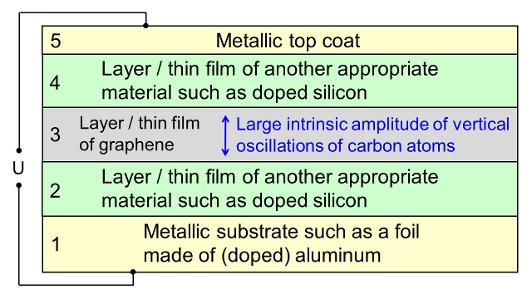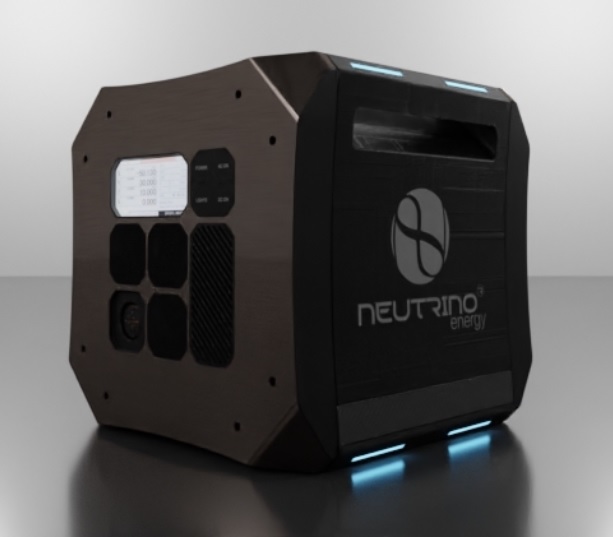Entirely novel and environmentally friendly energy technologies
So-called neutrino voltaic / cells / technology - Self-running and zero emission electrical DC generators without moving parts from the company Neutrino
Creation date 7 November 2021
Last update 7 June 2025
The foundation of the so-called neutrino voltaic is a special physical phenomenon which was / is observed by several researchers and inventors such as Skenderbeg Klaiqi [1] , namely that a proper metal foil with an appropriate coating generates a small and permanent DC voltage and power. An example which can be manually prepared is the layered arrangement
Appropriate metal (aluminum) foil | Special silicone tape | Fine graphite powder
Its manual manufacturing is shown in a video without sound in a German-language webpage from the Austrian soceity GAIA about the so-called neutrino voltaic: https://gaia-energy.org/neutrino-energy-neutrinovoltaik-waver-manuell-vs-industriell . There it is the left video under "Videos zur Veranschaulichung".
The company Neutrino and their partners are working on the reasearch, development, and advancement of the below sketched arrangement of materials. Website of the company Neutrino Energy Group Deutschland / Neutrino Inc. and its offical YouTube channel: https://neutrino-energy.com and https://www.youtube.com/@neutrinoenergy
Sketch of principle of the so-called neutrino voltaic / cell / technology from the author of this website

In case of appropriate materials and conditions a DC voltage U emerges between (1) and (5) and usable electrical energy and power can be extracted permanently and everywhere, i.e. this system represents a self-running and zero emission generator of DC electricity. The thickness of the layers (3) as well as (2) and (4) are in the nanometer range. The thickness of graphene is about 1 nm, see e.g. Ref. [2]. Graphene consists of a single layer of carbon atoms which are arranged in a honeycomb structure. A sheet of the so-called neutrino voltaic material comprises usually more than one double layer (3) plus (4), for example 12 x [(3) plus (4)] between (2) and (5). The manufacturing of a sheet of the so-called neutrino voltaic material is performed by depositing under vacuum or in a plasma layer by layer onto the substrate (1). A so-called neutrino voltaic cell comprises several sheets of the so-called neutrino voltaic material which are stacked on top of each other under a high mechanical pressure.
There is an associated and published patent application, namely WO2016142056A1, see e.g. https://patents.google.com/patent/WO2016142056A1/en . In a webpage of the website neutrino-energy.com , namely in https://neutrino-energy.com/patent-wo2016142056a1 , this patent application is still incorrectly labeled as patent (as of 7 June 2025). A patent application is not the same as a granted patent.
In 2021 the feasible power density of a sheet of the so-called neutrino voltaic material was specified as 50 W per square meter and several of them can be stacked on top of each other [3]. An area 20 cm x 30 cm of the so-called neutrino voltaic material generates a DC voltage up to 1,5 V and a DC current up to 2 A. If we consider the corresponding maximum DC power (1,5 V) x (2 A) = 3 W , then we obtain 50 W per square meter.
In the website https://neutrino-energy.com and related sources of information the
neutrinos, their properties, and their (potential) role for the
so-called neutrino voltaic is strongly highlighted. That appears
overemphasized because it is just a hypothesis that the generated energy
originates from the neutrinos or from an interaction with them.
Meanwhile the phrase "... neutrinos and other forms of radiation ..." is
often used.
The following webpage of the website neutrino-energy.com and related video present some considerations how the neutrino voltaic generates electric energy: https://neutrino-energy.com/powercube-neutrinovoltaic and https://www.youtube.com/watch?v=JQN4escE6t4
The
author of this website assumes that neutrinos and other forms of
radiation are not or only marginally involved when considering the
question from where the generated energy comes from. Instead the author
of this website assumes that the above-sketched layer arrangement
extracts usable energy from an everywhere present form of energy which is called space energy, vacuum energy, zero-point energy, or ether energy, see e.g. https://novam-research.com/resources/information-document.pdf .
The
company Neutrino and their partners are working on the development of a
self-running and zero emission propulsion for electric cars and self-running and zero emission electrical generators which can power a home for example. Here some of the intended specifications of such an electrical generator, called Neutrino Power Cube, which were communicated in 2021 [3]:
- Dimensions 65 x 85 x 120 cm
- Usable electric output power up to 5 kW in form of an adjustable DC voltage or 230 V AC or 380 V AC via an integrated DC / AC converter
- Internally
generated electric power up to 7 kW because up to 2 kW is used to
stabilize the temperature of the system (the usable electric power
generated by the so-called neutrino voltaic decreases with increasing
temperature)
- Estimated price about 15000 EUR
Picture of a so-called Neutrino Power Cube, a self-running and zero emission generator with an output power of 5 kW
Image source: Some videos which are posted in https://neutrino-energy.com and https://www.youtube.com/@neutrinoenergy , for example https://www.youtube.com/watch?v=JQN4escE6t4 and https://www.youtube.com/watch?v=LiswrRR8H2Q

Two videos about the so-called neutrino voltaic and the Neutrino Power Cube:
It is intended to perform in Austria a field test of the Neutrino Power Cubes. The Austrian soceity GAIA provides information about it (in German): https://gaia-energy.org/neutrinovoltaik-feldtest .
References and further information:
[1] German-language report on pages 4 - 6 in the March / April 2023 issue of the NET-Journal (ISSN 1420-9292) (in German)
[2] Anomalies in thickness measurements of graphene and few layer graphite crystals by tapping mode atomic force microscopy, P. Nemes-Incze et al., Carbon 46 (13) (2008) 1435 - 1442: https://doi.org/10.1016/j.carbon.2008.06.022 . This paper is also availabe via https://arxiv.org/abs/0812.0690
[3] On 11 September 2021 Holger Thorsten Schubart and Rainer Beyer from the company Neutrino Deutschland GmbH in Berlin in Germany presented a German-language talk in Zurich in Switzerland about the so-called neutrino voltaic / cells / technology. This event was organized by the Swiss Study Group for Free Energy SAFE (Schweizerische Arbeitsgemeinschaft für Freie Energie). A report about this presentation is published on pages 4 - 11 in the November / December 2021 issue of the German-language journal NET-Journal (ISSN 1420-9292)
[4] German-language information of the so-called neutrino voltaic by the Austrian soceity GAIA: https://gaia-energy.org/neutrinovoltaik
[5] On 18 June 2023 Roberto Reuter, Holger Thorsten Schubart, Dr. Thorsten Ludwig, and Andreas Manthey presented a German-language talk about the so-called neutrino voltaic and updates from the company Neutrino. Their talk was given during a German-language congress about novel energy technologies and related topics in Stuttgart in Germany on 17 and 18 June 2023. A German-language report about their talk is published on pages 31 and 32 in the July / August 2023 issue of the NET-Journal (ISSN 1420-9292). The pages 31 and 32 are part of a German-language report about the overall congress which is available via the following link (in German): http://www.borderlands.de/net_pdf/NET0723S9-33.pdf
[6] On 23 June 2024 Holger Thorsten Schubart from the company Neutrino Deutschland GmbH in Berlin in Germany presented a German-language talk about the so-called neutrino voltaic and updates from the company Neutrino. His presentation took place at a German-language conference about novel energy technologies and related topics nearby Stuttgart in Germany. The German-language conference program can be downloaded here
[7] Another way to generate energy via a graphene-based device is presented by Prof. Paul Thibado from the University of Arkansas and it is called "Charging Capacitors using Graphene Fluctuations" (published in January 2022): https://www.youtube.com/watch?app=desktop&v=cFO32QWJe1c . Related short video (published in November 2017): https://www.youtube.com/watch?v=wrleMqm3HiU